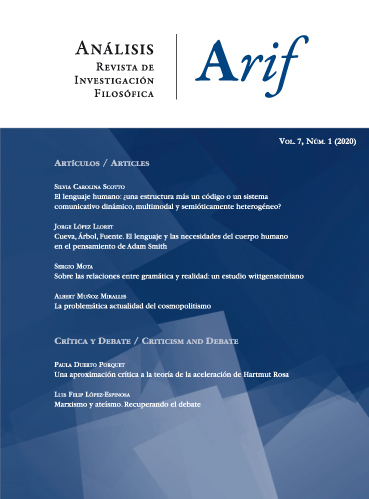Cave, Tree, Fountain. Language and Human Body Needs in Adam Smith’s Thought
DOI:
https://doi.org/10.26754/ojs_arif/a.rif.202013507Abstract
Between 1748 and 1764 Adam Smith defined a global and coherent philosophical project that he failed to publish in its entirety. The Theory of Moral Sentiments and The Wealth of Nations should be interpreted as parts of it that did come to be published. The present article presents as core elements of this project the Smithian theory of the origin of language and his vision of the human body as constitutively weak and sophisticated. Both are at the base of the historical process of socialization that, according to Smith, was together semiotic and economic in a non-problematic way. Finally, it reflects on the interest of this for the interpretation of Smith as an egalitarian no so focused on the marked and, from here, for our vision of ourselves as deficient beings that should expand their social ties as much as possible, because we need each other.
Downloads
Downloads
Published
How to Cite
Issue
Section
License
Los autores que publican en esta revista están de acuerdo con los siguientes términos: los autores conservan los derechos de autor y garantizan a la revista el derecho de ser la primera publicación del trabajo al igual que licenciado bajo una Creative Commons Reconocimiento-No Comercial-Sin Obra Derivada 4.0 (CC BY-NC-ND) que permite a otros compartir el trabajo con un reconocimiento de la autoría del trabajo y la publicación inicial en esta revista. Los autores pueden establecer por separado acuerdos adicionales para la distribución no exclusiva de la versión de la obra publicada en la revista (por ejemplo, situarlo en un repositorio institucional o publicarlo en un libro), con un reconocimiento de su publicación inicial en esta revista.






